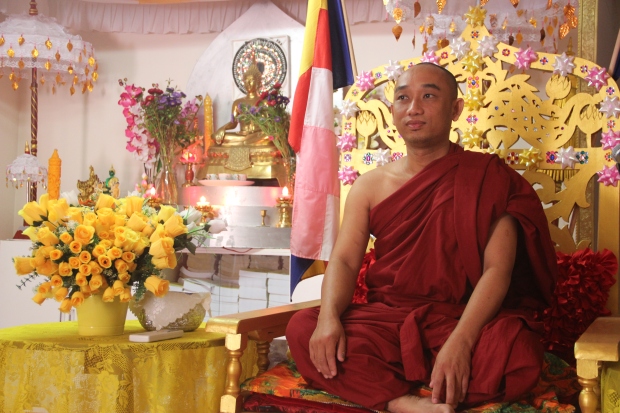From weekly Southeast Asia app/digital magazine The Edge Review www.theedgereview.com (subscription required)
March 6-12, 2015
How a small Australian city became an unlikely home for Karen refugees fleeing Myanmar
By SHANE WORRELL / Melbourne
A family home in suburbia has long been at the heart of the “Australian Dream”, an ideal that took root in the prosperous post-war 1950s.
Along with a secure job and an enviable set of wheels, one defining element was a back garden shed for men to tinker with cars while enjoying a beer and sport on the radio.
Beyond the stereotype, though, is an altogether more diverse Australia.
For one fast-growing refugee community 150 kilometres from Melbourne, the back shed – of one home, at least – is instead a Buddhist monastery, a place for vibrant religious and cultural gatherings.
“At our last festival here, we had about 100 people,” Karen Buddhist monk Ashin Moonieinda says, laughing. “We need something bigger.”
In common with tens of thousands of other ethnic Karen people, 15 years ago Moonieinda fled his village in Myanmar, where soldiers were killing, raping, torturing and enslaving people.
After years surviving on sparse rations in a refugee camp in Thailand, Moonieinda was granted a visa to live in Australia in 2007.
Attracted by the peaceful surrounds of the countryside, Moonieinda was the first Karen to settle in Bendigo, a city of about 105,000 people. Eight years on, the Karen community has grown to about 1,000 people, transforming the face of a city once known for being predominantly white. More than three-quarters of the Karen in Bendigo are Christian and the remainder Buddhist.
In 2013-14, humanitarian visas to live in Australia were granted to 1,819 people born in Myanmar, the third-highest after Afghanistan with 2,751 and Iraq with 2,364.
Moonieinda’s busy schedule is a snapshot of the challenges that Karen refugees face. As well as following his rituals as a Theravada Buddhist monk, the 38-year-old helps newly arrived families, provides temporary accommodation for youths battling problems, is an interpreter at medical and social services appointments and studies at university to be a social worker.
“Most of the parents never went to school before they came to Australia, so it has been very hard for them to learn how to read and write,” he explained of one of the key challenges.
Maree Edwards, a local member of Victoria’s state parliament, says the government and NGOs offer a growing number of support services for Karen refugees.“However, there are still problems with service access … In most cases, this is a language barrier issue more than anything else,” she said.
While the heads of many Karen households have found work at chicken farms or slaughterhouses, jobs for others have not come easy.
Complicated visa processes are “stifling” Karen people from getting employment, Edwards says. Then there’s the general difficulty of finding a job. Australia’s unemployment rate hit a 12-year high of 6.4 per cent last month, and youth unemployment hit 20 per cent, an 18-year high.
One of the most famous waves of migration in Australian history occurred from 1976 to 1986, when about 95,000 refugees poured in from war-torn Vietnam, Cambodia and Laos.
The prosperous lives built by many of those refugees give Moonieinda hope that the Karen people, too, can find happiness here.“It is easy for Karen people to improve their lives here – they are not being controlled,” he said. 
In his mind, though, are thoughts of a changing homeland. An end to the violence and instability that drove his community out of their homes may one day draw many back.
“Sometimes when I contact people in the camp, they say they want to go back to Burma because there is more freedom now,” Moonieinda said. “But others don’t believe the government. It will take a long time. It’s not easy to change.”
The thought of returning home himself evokes mixed feelings in the monk, who is now an Australian citizen – one intent on building his own Australian Dream.
With his shed fast becoming too small for cultural and religious festivals, Moonieinda plans to build a US$1.2 million monastery. Blueprints and floor plans are plastered to the wall of his shed.
“The project is not only for Buddhist or Karen families, everyone is welcome,” he promised.
***

